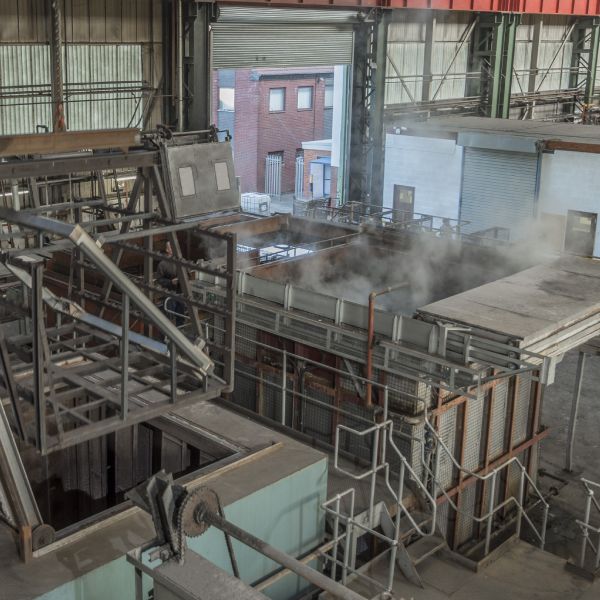The Heat Treatment Process Of Aluminium Alloys
Whether it’s preparing aluminium alloy components for aerospace applications, automotive aluminium applications, or general manufacturing needs, our processes ensures quality and reliability at every stage. Here’s an overview of the steps Alloy Heat Treatment follows to achieve the required standard for clients, along with insights into optional services offered to meet specific project requirements.
Solvent Degreasing/Cleaning
The journey begins with solvent degreasing and cleaning. This essential preparatory step removes oil, grease, dirt, and other surface contaminants from aluminium alloy components, ensuring a clean base for subsequent heat treatment stages. Using environmentally safe solvents, Alloy Heat Treatment ensures that no residual materials can interfere with the solution treatment, mechanical setting, or final outcomes. A clean surface is critical, as it allows the alloy to heat evenly and avoids potential imperfections.
Solution Treatment
Once aluminium alloy components are thoroughly cleaned, we move to the solution treatment stage, a high-temperature process that allows the alloy’s key metallic elements to dissolve uniformly into a super saturated solid solution (maximum possible concentration within solid aluminium). At this stage, aluminium alloy components are heated to a precise temperature specific to the material’s composition. By holding it at this temperature, Alloy Heat Treatment can achieve a uniform microstructure, followed by effective quenching (often using water or polymer glycol solution, which locks the material into its high-strength state by preventing unwanted phases from forming), of which both are fundamental necessities in preparation for precipitation hardening (aka age hardening or ageing). Solution treatment is not wholly necessary, when alloy aluminium alloy components are supplied for age hardening only, where the customer is responsible for supply of aluminium alloy components which have been effectively solution treated.
Mechanical Setting/Hammering
After solution treatment and quenching, certain aluminium alloy components may require mechanical setting, which is the art of using various sized hammers to manipulate quench distorted aluminium alloy components to meet specified dimensions. This process aligns aluminium alloy components to precise specifications and ensures any minor distortion that occurred during quenching, is corrected. This stage requires skilled technicians who carefully reshape or adjust the component, using dedicated tooling and precision gauges. However, not all quenched aluminium alloy components distort beyond critical dimensional limits during solution treatment and quenching, and so mechanical setting is not always necessary.
3D Scanning & Measurement
To ensure aluminium alloy components meet exacting standards, Alloy Heat Treatment employs advanced 3D scanning and measurement tools before and after mechanical setting. This highly accurate technique captures precise data on the component’s dimensions, allowing technicians to verify it matches the required specifications. This digital assessment not only ensures dimensional accuracy but also helps in identifying any subtle discrepancies before advancing to further stages of heat treatment.
Precipitation Hardening/Age Hardening
Once aluminium alloy component’s dimensions are confirmed, we move to the precipitation hardening stage—often known as age hardening or ageing. This process involves heating the alloy to a moderate temperature and holding it there for an extended period. During this stage, key intermetallic features precipitate within the solution treated microstructure, resulting in an increase in strength and hardness. This crucial step helps ensure the durability and longevity of the component, making it particularly valuable for aluminium alloy components which will be exposed to significant mechanical stress or wear during service.
Testing
After age hardening, various testing methods are employed to confirm the component’s required mechanical properties and structural integrity. Alloy Heat Treatment’s comprehensive testing includes hardness testing and tensile testing testing, and other quality assurance protocols. Testing can be customised based on industry standards, ensuring aluminium alloy components meet the specific demands of each application. High standards of testing are essential, particularly for aluminium alloy components used in safety-critical industries such as aerospace and automotive.
Dye-Penetrant Flaw Detection
Dye-penetrant flaw detection, also termed as dye-pen testing, is an important quality control method that follows testing. In this stage, a dye is applied to the component’s surface to reveal any surface-level imperfections, such as cracks, porosity, or leaks. This non-destructive testing technique is particularly effective for non-porous materials like aluminium and alloy and allows Alloy Heat Treatment to ensure each component’s surface is free from defects that could compromise performance or safety.
Shotblasting
Shotblasting often follows heat treatment and testing to remove surface dullness from aluminium alloy components, leaving heat treated aluminium alloy components with an aesthetically pleasing uniform matt silver finish. Shot blasting is the the projection of tiny stainless-steel shot, at high velocity on to component surfaces, removing undesired oxides, to create a smoother, uniform finish. This process not only improves the visual appeal of the component but may reduce any residual surface stresses from previous steps. Shotblasting is ideal for aluminium alloy components that will be visible in the final assembly or those requiring additional surface resilience.
Metallurgical Test Lab
The final step in Alloy Heat Treatment’s process involves a thorough metallurgical analysis conducted in our in-house test lab, where metallurgists examine the microstructure of the heat treated samples to verify that the heat treatment process has achieved the desired results. Metallurgical analysis also evaluates the performance of furnaces used used for heat treatment of aluminium alloys.
Optional and Stand-alone Heat Treatment Services
At Alloy Heat Treatment, each of these steps is available not only as part of a comprehensive heat treatment package but also as stand-alone services to cater to specific client needs. For example, a company may only require dye-penetrant flaw detection on previously treated aluminium alloy components, or just solution treatment for preliminary strengthening, or just softening via annealing or stress relieving. This flexibility allows Alloy Heat Treatment to serve a wide array of industries and project scopes, offering customised treatment plans that ensure each aluminium alloy component is fully prepared for its intended application.
Get A Heat Treatment Quote Today!
Get A Quote: https://alloyheat.co.uk/get-quote/
Alloy Heat Treatment’s methodical heat treatment process is designed to elevate the quality, strength, and durability of aluminium alloy components. Through precision and rigorous quality checks, our processes yield the required quality standards into processed aluminium alloy components, making us a trusted partner for companies that demand excellence in heat treatment.












